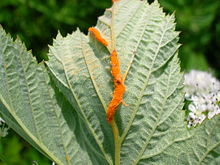- Meadowsweet rust gall
-
Meadowsweet rust gall Mature gall on a meadowsweet leaf Scientific classification Kingdom: Fungi Division: Basidiomycota Class: Pucciniomycetes Order: Pucciniales Family: Sphaerophragmiaceae Genus: Triphragmium Species: T. ulmariae Binomial name Triphragmium ulmariae
(DC.) Link (1825)[1]Synonyms[2] Puccinia ulmariae DC. (1808)
Triphragmium ulmariae is a species of fungus in the Sphaerophragmiaceae family. It causes meadowsweet rust gall, which develops as a chemically induced swelling, arising from the lower surface of the meadowsweet leaves.
Contents
Cause
This common gall is caused by the foliar 'rust' fungus Triphragmium ulmariae (DC.) Link, 1825 .[3]
Appearance
The fungus attacks the petioles and / or midribs of the perennial meadowsweet (Filipendula ulmaria) plant, a member of the Rosaceae family, causing swelling and distortion. Sori develop with bright orange spores.[3]
Life cycle
The rust's spores reach the meadowsweet via air movements and are spread from the galls that develop on the petioles and / or midrib veins.
Infestation
The rust has a severe effect on the survival of meadowsweet seedlings.[4]
See also
- Protomyces macrosporus
References
- ^ Biolimages
- ^ "Triphragmium ulmariae (DC.) Link 1825". MycoBank. International Mycological Association. http://www.mycobank.org/MycoTaxo.aspx?Link=T&Rec=203857. Retrieved 2011-07-08.
- ^ a b Stubbs, F. B. Edit. (1986) Provisional Keys to British Plant Galls. Pub. Brit Plant Gall Soc. ISBN 0-9511582-0-1. P. 27.
- ^ CABI Abstracts
External links
Categories:- Galls
- Rosaceae
- Pucciniales
- Fungi described in 1808
Wikimedia Foundation. 2010.

